torque SKODA OCTAVIA TOUR 2009 1.G / (1U) Owner's Manual
[x] Cancel search | Manufacturer: SKODA, Model Year: 2009, Model line: OCTAVIA TOUR, Model: SKODA OCTAVIA TOUR 2009 1.G / (1U)Pages: 226, PDF Size: 13.11 MB
Page 179 of 226
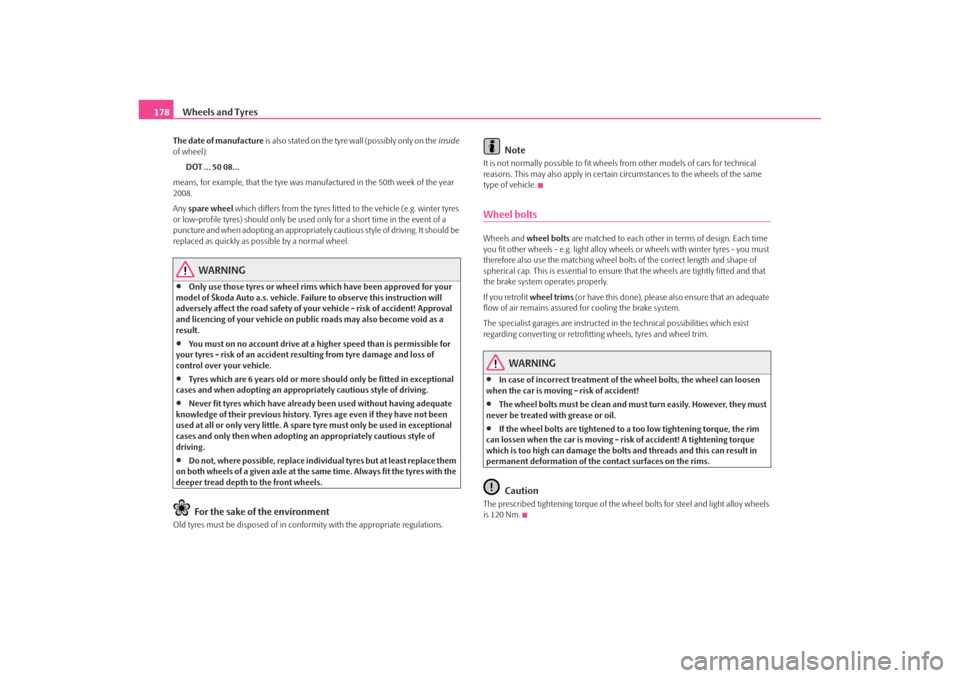
Wheels and Tyres
178The date of manufacture is a lso s tated on the tyre wal l (poss ibly o nl y on the inside
of wheel):
DOT ... 50 08...
means, for example, that the tyre was manufactured in the 50th week of the year
2008.
Any spare wheel which differs from the tyres fitted to the vehicle (e.g. winter tyres
or low-profile tyres) should only be used only for a short time in the event of a
puncture and when adopting an appropriately cautious style of driving. It should be
replaced as quickly as po ssible by a normal wheel.
WARNING
•
Only use those tyres or wheel rims which have been approved for your
model of Škoda Auto a.s. vehicle. Failure to observe this instruction will
adversely affect the road safety of your vehicle - risk of accident! Approval
and licencing of your vehicle on public roads may also become void as a
result.
•
You must on no account drive at a higher speed than is permissible for
your tyres - risk of an accident resulting from tyre damage and loss of
control over your vehicle.
•
Tyres which are 6 years old or more should only be fitted in exceptional
cases and when adopting an appropriately cautious style of driving.
•
Never fit tyres which have already been used without having adequate
knowledge of their previous history. Ty res age even if they have not been
used at all or only very little. A spare tyre must only be used in exceptional
cases and only then when adopting an appropriately cautious style of
driving.
•
Do not, where possible, replace indivi dual tyres but at least replace them
on both wheels of a given axle at the same time. Always fit the tyres with the
deeper tread depth to the front wheels.For the sake of the environment
Old tyres must be disposed of in conformity with the appropriate regulations.
Note
It is not normally possible to fit wheels from other models of cars for technical
reasons. This may also apply in certain circumstances to the wheels of the same
type of vehicle.Wheel boltsWheels and wheel bolts are matched to each other in terms of design. Each time
you fit other wheels - e.g. light alloy wheels or wheels with winter tyres - you must
therefore also use the matching wheel bolts of the correct length and shape of
spherical cap. This is essent ial to ensure that the wheels are tightly fitted and that
the brake system operates properly.
If you retrofit wheel trims (or have this done), please also ensure that an adequate
flow of air remains assured for cooling the brake system.
The specialist garages are instructed in the technical possibilities which exist
regarding converting or retrofitti ng wheels, tyres and wheel trim.
WARNING
•
In case of incorrect treatment of th e wheel bolts, the wheel can loosen
when the car is moving - risk of accident!
•
The wheel bolts must be clean and must turn easily. However, they must
never be treated with grease or oil.
•
If the wheel bolts are tightened to a too low tightening torque, the rim
can lossen when the car is moving - risk of accident! A tightening torque
which is too high can damage the bolts and threads and this can result in
permanent deformation of the contact surfaces on the rims.Caution
The prescribed tightening torque of the wh eel bolts for steel and light alloy wheels
is 120 Nm.
s2ig.book Page 178 Monday, November 10, 2008 11:20 AM
Page 187 of 226
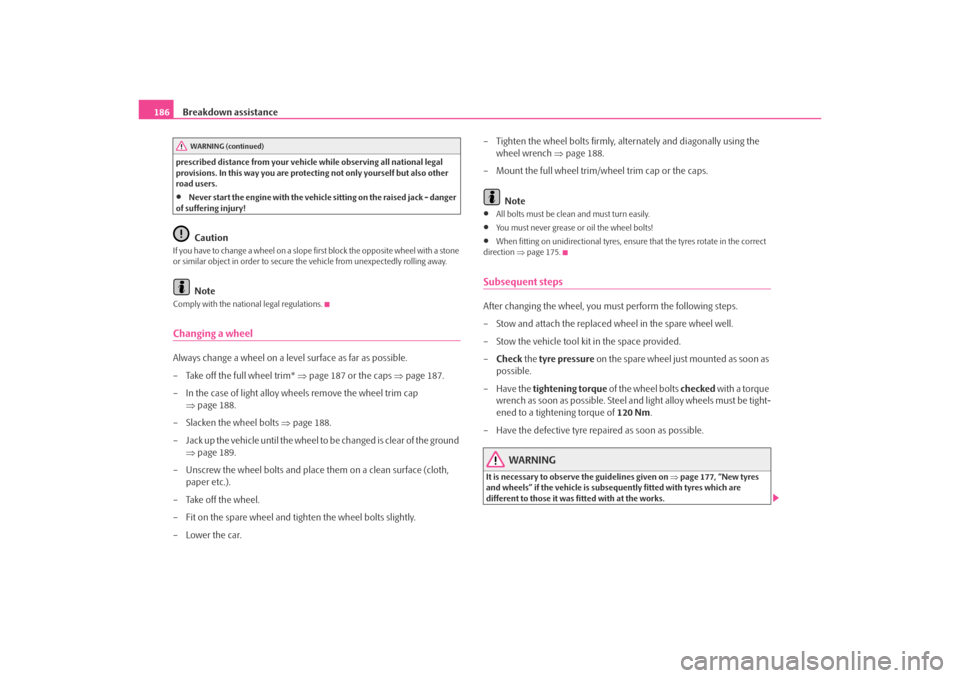
Breakdown assistance
186prescribed distance from your vehicl e while observing all national legal
provisions. In this way you are protecting not only yourself but also other
road users.•
Never start the engine with the vehicle sitting on the raised jack - danger
of suffering injury!Caution
If you have to change a wheel on a slope first block the opposite wheel with a stone
or similar object in order to secure th e vehicle from unexpectedly rolling away.
Note
Comply with the national legal regulations.Changing a wheelAlways change a wheel on a level surface as far as possible.
– Take off the full wheel trim* ⇒page 187 or the caps ⇒page 187.
– In the case of light alloy wheels remove the wheel trim cap ⇒page 188.
– Slacken the wheel bolts ⇒page 188.
– Jack up the vehicle until the wheel to be changed is clear of the ground
⇒ page 189.
– Unscrew the wheel bolts and place them on a clean surface (cloth, paper etc.).
– Take off the wheel.
– Fit on the spare wheel and tighten the wheel bolts slightly.
–Lower the car. – Tighten the wheel bolts firmly, al
ternately and diagonally using the
wheel wrench ⇒page 188.
– Mount the full wheel trim/w heel trim cap or the caps.
Note
•
All bolts must be clean and must turn easily.
•
You must never grease or oil the wheel bolts!
•
When fitting on unidirectional tyres, ensure that the tyres rotate in the correct
direction ⇒page 175.
Subsequent stepsAfter changing the wheel, you must perform the following steps.
– Stow and attach the replaced wheel in the spare wheel well.
– Stow the vehicle tool kit in the space provided.
– Check the tyre pressure on the spare wheel just mounted as soon as
possible.
– Have the tightening torque of the wheel bolts checked with a torque
wrench as soon as possible. Steel and light alloy wheels must be tight-
ened to a tightening torque of 120 Nm.
– Have the defective tyre repaired as soon as possible.
WARNING
It is necessary to observe the guidelines given on ⇒page 177, “New tyres
and wheels” if the vehicle is subseq uently fitted with tyres which are
different to those it was fitted with at the works.
WARNING (continued)
s2ig.book Page 186 Monday, November 10, 2008 11:20 AM
Page 188 of 226

Breakdown assistance187
Using the system
Safety
Driving Tips
General Maintenance
Breakdown assistance
Technical Data
Note
•
If you find, when changing the wheel, that the wheel bolts are corroded and
difficult to turn, the bolts mu st be replaced before checking the tightening torque.
•
Drive cautiously and only at a moderate speed to a workshop where the tight-
ening torque can be checked.
Full wheel trim*Pulling off
– Hook the clamp found in the vehicle tool kit into the reinforced edge of the full wheel trim.
– Push the wheel key through the clamp, support the wheel key on the tyre and pull off the wheel trim ⇒fig. 168 .
Installing
– First press the full wheel trim onto the wheel at the valve opening provided. Then press the full wheel trim into the wheel in such a way
that its entire circumference locks correctly in place. Caution
•
Use the pressure of your hand, do not knock on the full wheel trim! Heavy
knocks mainly on the points where the full wheel trim has not been inserted into
the wheel, can result in damage to the guide and centering elements of the full
wheel trim.
•
First check for yourself that the theft-deterrent wheel bolt is located
⇒ page 189, “Securing wheels against being stolen*” in the hole in the area of the
valve before fitting the full wheel trim on to a steel wheel which is attached with a
theft-deterrent wheel bolt.
Wheel bolts with caps*Pulling off
– Push the plastic clip sufficiently fa r onto the cap until the inner catches
of the clip are positioned at the collar of the cap and detach the cap.
Installing
– Push the caps fully onto the wheel bolts.The caps are located in the we ll of the luggage compartment.
Fig. 168 Removing the full
wheel trim
Fig. 169 Removing the cap.
s2ig.book Page 187 Monday, November 10, 2008 11:20 AM
Page 191 of 226
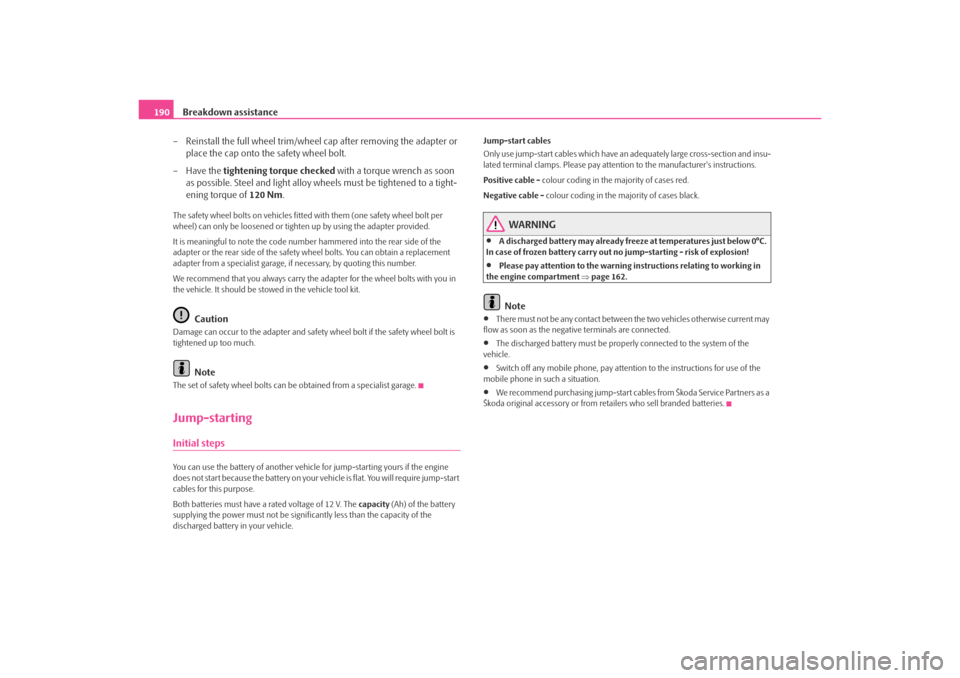
Breakdown assistance
190
– Reinstall the full wheel trim/wheel cap after removing the adapter or place the cap onto the safety wheel bolt.
– Have the tightening torque checked with a torque wrench as soon
as possible. Steel and light alloy wh eels must be tightened to a tight-
ening torque of 120 Nm.The safety wheel bolts on vehicles fitted with them (one safety wheel bolt per
wheel) can only be loosened or tigh ten up by using the adapter provided.
It is meaningful to note the code numbe r hammered into the rear side of the
adapter or the rear side of the safety wheel bolts. You can obtain a replacement
adapter from a specialist garage, if necessary, by quoting this number.
We recommend that you always carry the adapter for the wheel bolts with you in
the vehicle. It should be st owed in the vehicle tool kit.
Caution
Damage can occur to the adapter and safety wheel bolt if the safety wheel bolt is
tightened up too much.
Note
The set of safety wheel bolts can be obtained from a specialist garage.Jump-startingInitial stepsYou can use the battery of another vehicl e for jump-starting yours if the engine
does not start because the battery on your vehicle is flat. You will require jump-start
cables for this purpose.
Both batteries must have a rated voltage of 12 V. The capacity (Ah) of the battery
supplying the power must not be significa ntly less than the capacity of the
discharged battery in your vehicle. Jump-start cables
Only use jump-start cables which have an
adequately large cross-section and insu-
lated terminal clamps. Please pay attent ion to the manufacturer's instructions.
Positive cable - colour coding in the majority of cases red.
Negative cable - colour coding in the majority of cases black.
WARNING
•
A discharged battery may already freeze at temperatures just below 0°C.
In case of frozen battery carry out no jump-starting - risk of explosion!
•
Please pay attention to the warning instructions relating to working in
the engine compartment ⇒page 162.Note
•
There must not be any contact between the two vehicles otherwise current may
flow as soon as the negative terminals are connected.
•
The discharged battery must be properly connected to the system of the
vehicle.
•
Switch off any mobile phone, pay attent ion to the instructions for use of the
mobile phone in such a situation.
•
We recommend purchasing jump-start cabl es from Škoda Service Partners as a
Škoda original accessory or from retailers who sell branded batteries.
s2ig.book Page 190 Monday, November 10, 2008 11:20 AM
Page 204 of 226
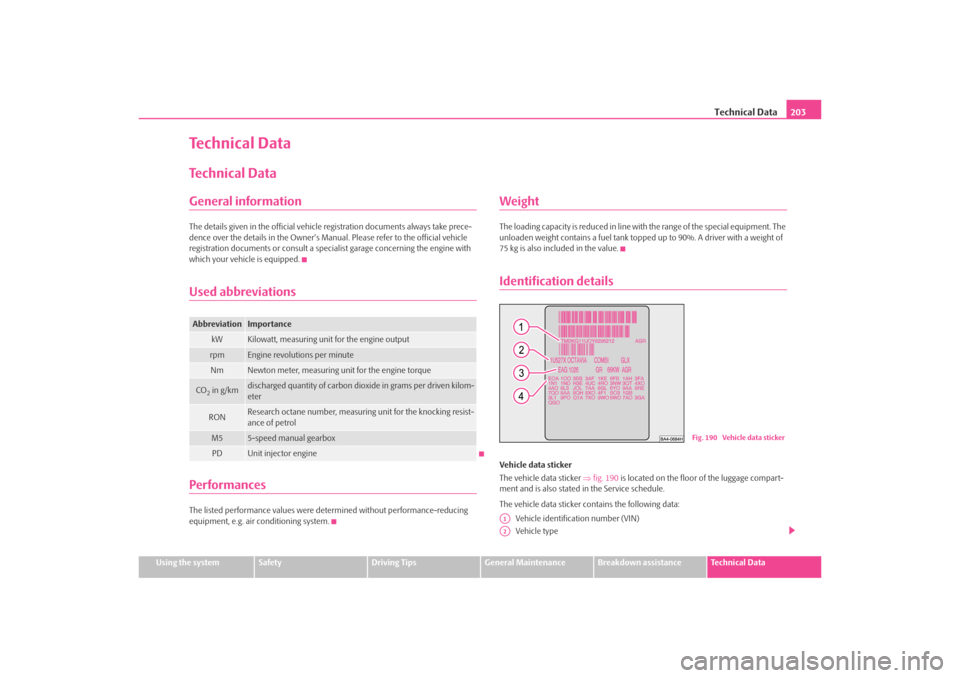
Technical Data203
Using the system
Safety
Driving Tips
General Maintenance
Breakdown assistance
Technical Data
Technical DataTechnical DataGeneral informationThe details given in the official vehicle registration documents always take prece-
dence over the details in th e Owner's Manual. Please refer to the official vehicle
registration documents or consult a specia list garage concerning the engine with
which your vehicle is equipped.Used abbreviationsPerformancesThe listed performance values were determined without performance-reducing
equipment, e.g. air conditioning system.
WeightThe loading capacity is reduced in line with the range of the special equipment. The
unloaden weight contains a fu el tank topped up to 90%. A driver with a weight of
75 kg is also included in the value.Identification detailsVehicle data sticker
The vehicle data sticker ⇒fig. 190 is located on the floor of the luggage compart-
ment and is also stated in the Service schedule.
The vehicle data sticker co ntains the following data:
Vehicle identificati on number (VIN)
Vehicle type
Abbreviation
Importance
kW
Kilowatt, measuring unit for the engine output
rpm
Engine revolutions per minute
Nm
Newton meter, measuring unit for the engine torque
CO2 in g/km
discharged quantity of carbon dioxide in grams per driven kilom-
eter
RON
Research octane number, measur ing unit for the knocking resist-
ance of petrol
M5
5-speed manual gearbox
PD
Unit injector engine
Fig. 190 Vehicle data sticker
A1A2
s2ig.book Page 203 Monday, November 10, 2008 11:20 AM
Page 207 of 226
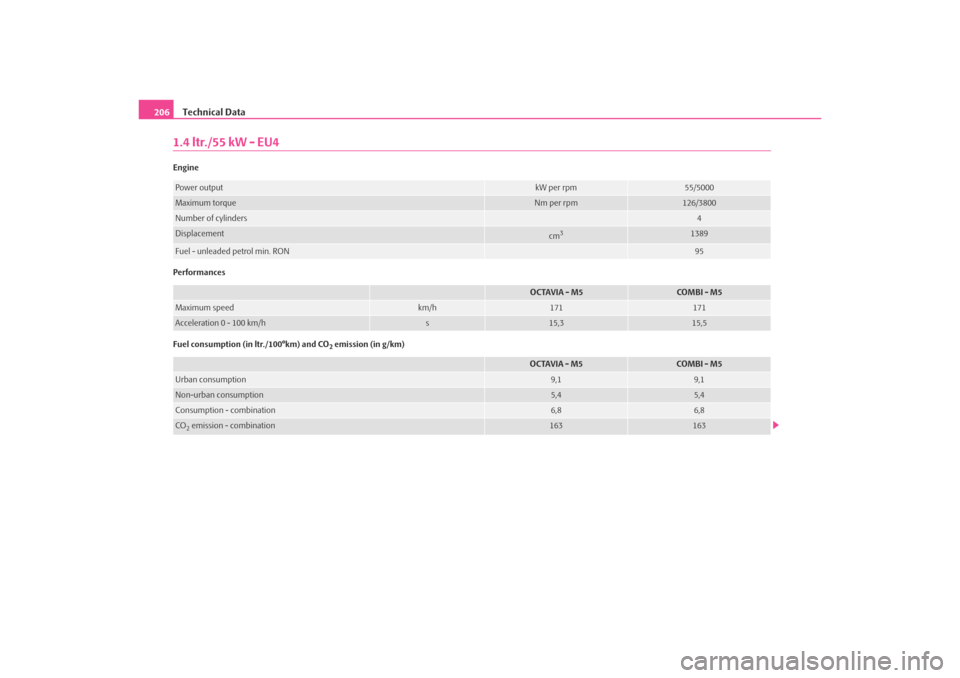
Technical Data
2061.4 ltr./55 kW - EU4Engine
Performances
Fuel consumption (in ltr./100°km) and CO
2 emission (in g/km)
Power output
kW per rpm
55/5000
Maximum torque
Nm per rpm
126/3800
Number of cylinders
4
Displacement
cm3
1389
Fuel - unleaded petrol min. RON
95
OCTAVIA - M5
CO M B I - M 5
Maximum speed
km/h
171
171
Acceleration 0 - 100 km/h
s
15,3
15,5
OCTAVIA - M5
COMBI - M5
Urban consumption
9,1
9,1
Non-urban consumption
5,4
5,4
Consumption - combination
6,8
6,8
CO2 emission - combination
163
163
s2ig.book Page 206 Monday, November 10, 2008 11:20 AM
Page 209 of 226
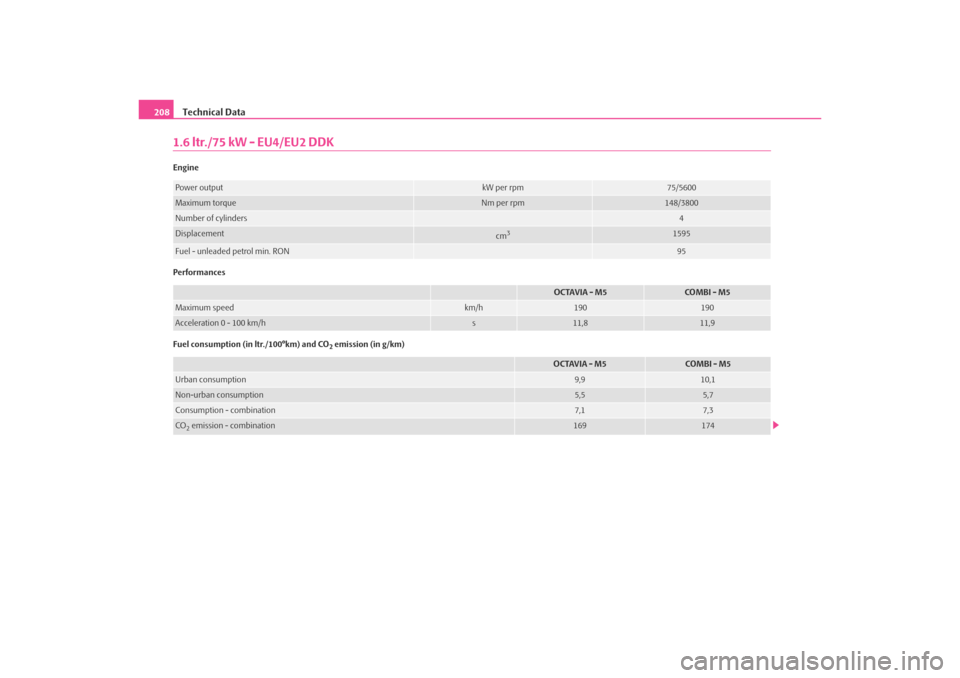
Technical Data
2081.6 ltr./75 kW - EU4/EU2 DDKEngine
Performances
Fuel consumption (in ltr./100°km) and CO
2 emission (in g/km)
Power output
kW per rpm
75/5600
Maximum torque
Nm per rpm
148/3800
Number of cylinders
4
Displacement
cm3
1595
Fuel - unleaded petrol min. RON
95
OCTAVIA - M5
CO M B I - M 5
Maximum speed
km/h
190
190
Acceleration 0 - 100 km/h
s
11,8
11,9
OCTAVIA - M5
COMBI - M5
Urban consumption
9,9
10,1
Non-urban consumption
5,5
5,7
Consumption - combination
7,1
7,3
CO2 emission - combination
169
174
s2ig.book Page 208 Monday, November 10, 2008 11:20 AM
Page 211 of 226
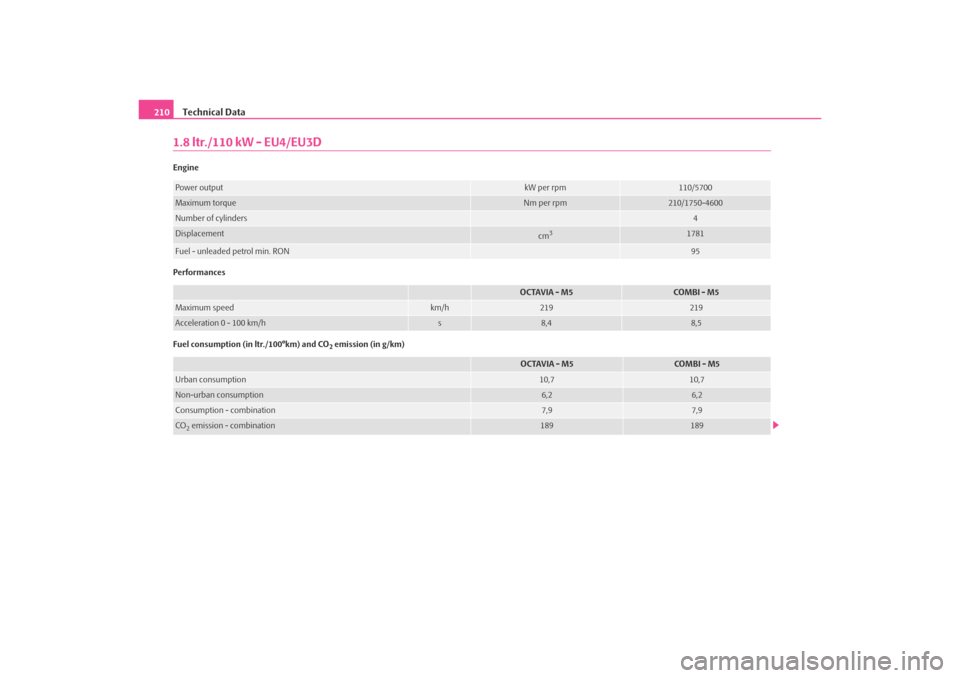
Technical Data
2101.8 ltr./110 kW - EU4/EU3DEngine
Performances
Fuel consumption (in ltr./100°km) and CO
2 emission (in g/km)
Power output
kW per rpm
110/5700
Maximum torque
Nm per rpm
210/1750-4600
Number of cylinders
4
Displacement
cm3
1781
Fuel - unleaded petrol min. RON
95
OCTAVIA - M5
COMBI - M5
Maximum speed
km/h
219
219
Acceleration 0 - 100 km/h
s
8,4
8,5
OCTAVIA - M5
COMBI - M5
Urban consumption
10,7
10,7
Non-urban consumption
6,2
6,2
Consumption - combination
7,9
7,9
CO2 emission - combination
189
189
s2ig.book Page 210 Monday, November 10, 2008 11:20 AM
Page 213 of 226

Technical Data
2121.9 ltr./66 kW TDI - EU3Engine
Performances
Fuel consumption (in ltr./100°km) and CO
2 emission (in g/km)
Power output
kW per rpm
66/4000
Maximum torque
Nm per rpm
210/1900
Number of cylinders
4
Displacement
cm3
1896
Fuel
Diesel
OCTAVIA - M5
COMBI - M5
Maximum speed
km/h
182
182
Acceleration 0 - 100 km/h
s
13,0
13,3
OCTAVIA - M5
COMBI - M5
Urban consumption
6,6
6,6
Non-urban consumption
4,2
4,2
Consumption - combination
5,0
5,0
CO2 emission - combination
135
135
s2ig.book Page 212 Monday, November 10, 2008 11:20 AM
Page 215 of 226
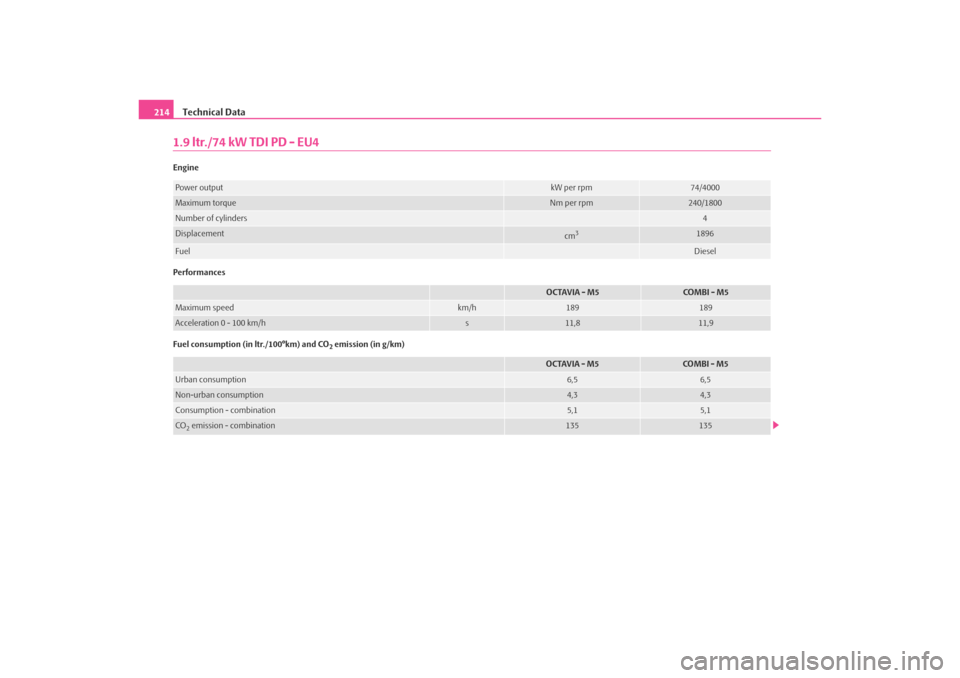
Technical Data
2141.9 ltr./74 kW TDI PD - EU4Engine
Performances
Fuel consumption (in ltr./100°km) and CO
2 emission (in g/km)
Power output
kW per rpm
74/4000
Maximum torque
Nm per rpm
240/1800
Number of cylinders
4
Displacement
cm3
1896
Fuel
Diesel
OCTAVIA - M5
COMBI - M5
Maximum speed
km/h
189
189
Acceleration 0 - 100 km/h
s
11,8
11,9
OCTAVIA - M5
COMBI - M5
Urban consumption
6,5
6,5
Non-urban consumption
4,3
4,3
Consumption - combination
5,1
5,1
CO2 emission - combination
135
135
s2ig.book Page 214 Monday, November 10, 2008 11:20 AM